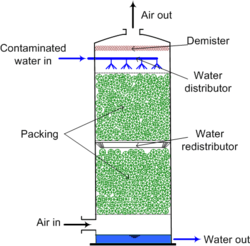Air stripping

Air stripping is the transferring of volatile components of a liquid into an air stream. It is an environmental engineering technology used for the purification of groundwaters and wastewaters containing volatile compounds.
Volatile compounds have relatively high vapor pressure and low aqueous solubility characterized by the compound’s Henry's law coefficient, which is the ratio of the concentration in air that is in equilibrium with its concentration in water. Pollutants with relatively high Henry’s Law coefficients can be economically stripped from water. These include BTEX compounds (benzene, toluene, ethylbenzene, and xylene found in gasoline), and solvents including trichloroethylene and tetrachloroethylene. Ammonia can also be stripped from wastewaters and liquid digestates (often requiring pH adjustment prior to stripping). Since Henry’s law coefficient increases with temperature, stripping is easier at warmer temperatures.
Air strippers
Although any device that promotes contact between air and water strips some volatile compounds, air strippers are usually packed towers or tray towers operated with countercurrent flow of water and air. Packed towers, such as shown in Figure 1, usually use engineered or random plastic packings. Design criteria for packed towers include surface area provided by the packing, column height and diameter, and air to water flow rates.
Since many of the compounds stripped are hazardous air pollutants, the air exiting a stripper may require emissions control. Carbon adsorption is often used and catalytic oxidation is another option.
See also
References
- Henry Z. Kister (1992). Distillation Design (1st ed.). McGraw-Hill. ISBN 0-07-034909-6.
- Perry, R.H.; Green, D.W., eds. (1997). Perry's Chemical Engineers' Handbook (7th ed.). McGraw-Hill. ISBN 0-07-049841-5.
External links
- Air Stripping, archived from a website page of the Federal Remediation Technologies Roundtable
- Air Stripping of VOCs from Water
- Air Stripping, Design Guide 1110-1-3, archived from website page of the U.S. Army Corps of Engineers
- Sliding Tray Air Stripper Overview, Overview of how Air Strippers work.